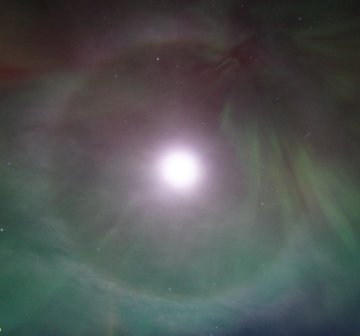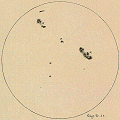BLUE SKIES ON SATURN: Earth isn't the only planet with blue skies. Saturn has them, too, according to NASA's Cassini spacecraft. Get the full story from Science@NASA.
 Would you like a call when the ISS is about to fly over your backyard? Sign up for SpaceWeather PHONE.
Would you like a call when the ISS is about to fly over your backyard? Sign up for SpaceWeather PHONE.
SNOW MOON: According to folklore, February's full moon is called the Snow Moon. Moonlight shining on white snowy ground makes the night unusually bright. This year's Snow Moon is due on Feb. 22nd and 23rd.
When the moon is bright and the air is cold, be alert for moon halos, pillars and 'dogs. These are caused by ice crystals in the air bending moonlight into beautiful shapes. (continued below)

Arne Danielsen took this picture of a moon halo over Langhus, Norway (air temperature -4o C), on Jan. 21st. The green and purple curtains are auroras. They have nothing to do with the moon or its halo. Auroras, a result of solar activity, occur 100+ km above Earth's surface. Halo-making ice crystals float just 5 to 10 km above the ground. So the auroras in this picture are high above the halo--contrary to appearances.
Good news: You don't have to live in a cold place like Norway to see icy moon halos. It's always cold enough for ice crystals 10 km above the ground--even in, say, Florida or Arizona. Everyone should keep an eye on the Snow Moon.
GALILEO & SUNSPOTS: Galileo Galilei is an important person in the history of space weather. Contrary to popular belief, he didn't discover sunspots, but he was one of the first to observe them using a telescope. (His favorite method: solar projection.)
 In Galileo's day, circa 1612, many people believed sunspots were satellites of the sun. Galileo proved otherwise. By drawing sunspots every day, he discovered that the sun spins (once every 27 days) and that sunspots must be located on or very near the sun's surface. Galileo thought sunspots might be clouds.
In Galileo's day, circa 1612, many people believed sunspots were satellites of the sun. Galileo proved otherwise. By drawing sunspots every day, he discovered that the sun spins (once every 27 days) and that sunspots must be located on or very near the sun's surface. Galileo thought sunspots might be clouds.
Now we know what sunspots really are: islands of magnetism. Magnetic force-fields poke through the sun's surface from below, creating a region of relatively cool, dark gas--a sunspot. Sometimes these magnetic fields erupt, producing a solar flare or a coronal mass ejection.
More than four centuries after Galileo, astronomers are still watching the sun and drawing sunspots. Click here to view watercolor paintings of three big sunspots last November. "Foreshortening can be seen in the sunspot groups near the limb and the sunspots appear to move faster near the limb," says artist John Stetson. "Historically, both foreshortening and apparent speed provided key evidence that sunspots were on the surface of the sun."

